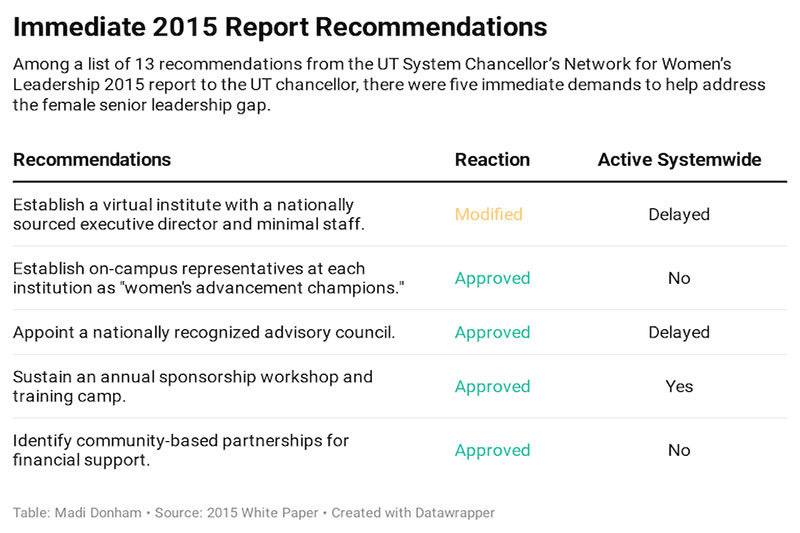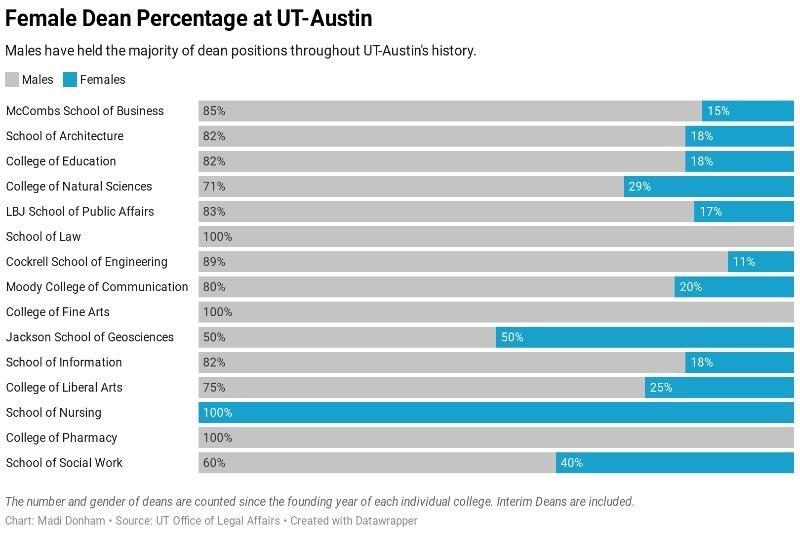Gender Gap Persists in UT System Senior Leadership
By Madi Donham
Reporting Texas

The University of Texas System Building stands in downtown Austin on Dec. 10, 2020. Madi Donham/Reporting Texas
On a summer day in Houston in 2011, Elizabeth Travis, associate vice president for women and minority faculty inclusion at the UT-affiliated M.D. Anderson Cancer Center, gathered more than a dozen women from the UT System to discuss the advancement of women
The gathering was the start of the UT System Chancellor’s Network for Women’s Leadership. In 2015, after four years of data gathering and focus groups, the network sent a report to UT system Chancellor William McRaven. The report detailed how women were underrepresented in leadership positions in the system and made a number of recommendations.
There was “no perception of any intention to actively promote the advancement of women across the UT System,” and a “hands-off policy has led to the current state of under-representation of women in these roles,” the report stated.
While McRaven accepted most of the proposals, little concrete action has occurred to implement them (see table). Since James Milliken replaced McRaven as chancellor in 2018, efforts to expand the role of women in executive leadership has occurred at the institutional rather than system level.
After receiving the 2015 report, McRaven and the UT system did work to identify and interview women and diverse candidates for leadership positions. Tangible progress resulted. At UT-Austin, the UT System flagship institution, four of 15 deans were female in 2015. In 2020, that number has risen to six of 15. The 2015 report’s authors acknowledge the progress, but say more needs to be done.
Dr. Susan John, chair of the Department of Diagnostic and Intervention Imaging at the University of Texas McGovern Medical School at Houston, coauthored the 2015 report. She went to UT-Austin as an undergraduate and has spent her entire career in the UT System.
John remembers that the immediate response from the system was supportive and reasonably enthusiastic.
“But I don’t recall that there was sort of an instant affirmation that there was going to be funding for a bunch of programs,” John said.
“Culture change does not happen quickly — and, you know, UT is a Texas institution, and Texas itself has a culture and a reputation around gender that I think is changing, but maybe not as fast as we would like to,” John said.
Although there has been recognition of the importance of helping women advance to higher levels of authority and responsibility, there wasn’t a coordinated effort at the UT System level until recently, John said.
The UT System is working to address the gender gap, system spokeswoman Karen Adler said. The biggest accomplishment since the 2015 report is a policy known as the Opportunity Rule, Adler added. The policy ensures that qualified women, men and members of underrepresented groups have an opportunity to be considered for senior leadership positions — including deans, presidents and chancellors at every UT institution.
Since the policy was implemented in 2017, UT institutions have hired women for 46% of open executive administrative positions, Adler said.
The Opportunity Rule requires that senior positions be filled through a search process that delivers female, male and underrepresented candidates.
“There is, of course, more work to be done,” Adler added, “and the UT System will continue to explore and implement practices and policies to promote gender equity
There are 14 institutions in the UT System. There have only been seven women presidents out of 147; at UT-Austin, only Lorene Rogers has served, from 1974-79 . Women make up 30% of college presidents in the U.S., according to the American Council on Education. There has not been a woman chancellor in the system’s 70-year history.
One of the problems is that fewer women apply for senior leadership roles, experts say. An internal report form Hewlett Packard referenced in the Harvard Business Review found that men tend to apply for a job when they meet 60% of the listed qualifications, but women tend to apply only if they meet 100% of them.
Claudia Mora, dean of the Jackson School of Geosciences at UT-Austin, said in the past, a boy’s club culture existed in the UT System, and that culture has a legacy that resonates today.
In the UT System, deans are chosen by university presidents. Most finalists are selected by a dean search committee and candidates surface through the committee or by referrals.
“Oftentimes, it depends on the club that selects you and how comfortable they are with you. If the club is mostly white men, they will probably find they will choose a white male candidate,” Mora said.
Women sometimes have the added challenges of balancing career advancement with raising children. The UT system, as well as the rest of higher education, still needs to work to provide women opportunities for career advancement, Mora said.
“Systems like this are really hard to change — It’s a hurdle with each step of their job, and it’s not a glass ceiling, it’s a whole series of them,” Mora said.
System spokeswoman Adler said more work needs to be done and that the system is committed to doing it. “The UT System will continue to explore and implement practices and policies to promote gender equity,” Adler said.

